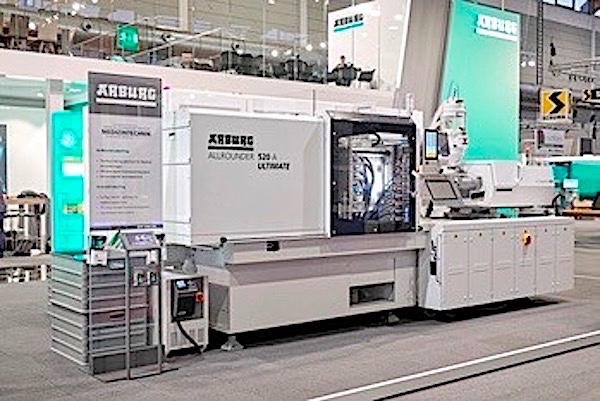Packaging
Allrounder 520 A: Highly innovative IML application for medical technology Sabine

Saturday 23. March 2024 - Prestigious partners Kebo (mould), MCC Verstraete (label), Beck (automation) and Intravis (camera inspection) are all involved in the innovative joint IML project centred around an electric Allrounder 520 A in clean room design.
• Innovative: In-mould labelling (IML) for centrifuge tubes creates added value
• Sustainable: Medical technology products with adhesive-free IML labels made from mono-material
• In partnership: Joint project around high-performance electric machine
While in-mould labelling (IML) is standard for packaging products, this process is still rarely used in the medical industry. Using a centrifuge tube plus label made of PP mono-material as an example, Arburg will be presenting a sustainable IML application with high repetition accuracy and added value for the pharmaceutical and medical technology industries at NPE 2024.
The ready-to-use product is manufactured in a fast, space-saving and cost-efficient way using a turnkey system centred around an electric Allrounder, without any additional hygiene risks.
Sustainable: Product made from mono-material
The pioneering technology was first presented as a proof of concept at Fakuma 2023 and met with a great response. The product is also particularly interesting in terms of sustainability: the tube and label are both made of PP, meaning that the mono-material product can be easily recycled. Because the integrated label can contribute to the stability of the tube, its wall thickness can be reduced if necessary and plastic material can be reduced in volume production. In addition, work steps such as bonding and printing are eliminated, meaning that no adhesives are required and there is no waste due to contamination with liquid colour.
Electric: High-performance machine for medical technology
Another important aspect is the compact footprint of the production cell, which fits into predefined production grids. The centrepiece is an electric Allrounder 520 A “Ultimate” with a clamping force of 1,500 kN, designed for fast and sophisticated processes. The high-performance machine in clean room design meets the requirements of class ISO 7. With an 8-cavity mould from Kebo, ready-to-use tubes, each with a capacity of 15 millilitres, are produced from PP in a cycle time of around 10 seconds. The servo-electric drives of the injection moulding machine ensure precise and reproducible mould positioning. A label adjustment head from Beck ensures that the labels are precisely aligned and applied, while a camera system from Intravis integrated into the automation handles the visual inspection of the finished parts in real time. In a real application, the tubes could also be screwed together and packaged in tubular bags in the production cell.
Precise: Accurate positioning of the functional labels
While the print to cut distance for IML decorations for packaging products is usually around 1 to 1.5 millimetres, it is only around 0.2 millimetres for the centrifuge tube application example. The labels with a wall thickness of 57 micrometres must be positioned as precisely as possible in the cavities. The labels are precisely aligned and applied using an automated system from Beck. A label adjustment head equalises the manufacturing tolerance to a few hundredths. This is an important requirement for functionality and significantly reduces quality fluctuations and rejects.
Integrated: Additional functions
Primarily, the tubes have a scale on the scratch-resistant label that indicates the exact fill level. These types of labels with inscriptions are also interesting for insulin pens and medical measuring cups, for example. Another function is the monitoring of temperature profiles. An additional temperature-sensitive element allows any interruption in the cold chain to be detected at a glance: as soon as the temperature of the filled tube rises above seven degrees Celsius, for example, the thermochromic printing ink changes irreversibly. Additional information on recycling and warehouse management can also be added to the product using a QR code, for example. In the future, it is also conceivable that the process, quality and patient data for each individual part will be 100% traceable via an RFID code.
